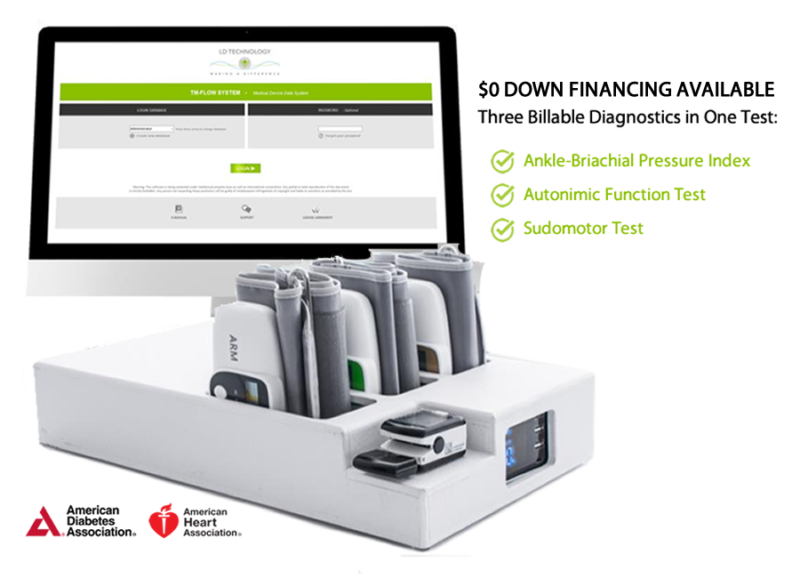Frequently Asked Questions
The TM Flow device offers numerous benefits for medical practices, including non-invasive and accurate testing, early detection of autonomic and arterial dysfunctions, and comprehensive diagnostics that reduce the overall cost of patient care. Additionally, the device’s tests are easy to bill with multi-code diagnostics, making it a valuable investment for enhancing patient care and optimizing practice efficiency. It also supports compliance with standards of care recommended by leading health organizations.
Yes, the TM Flow device is covered by Medicare and most private pay carriers. Specific CPT codes, such as 95921 for cardiovagal innervation and 93923 for ankle-brachial pressure index, ensure that the diagnostics are easy to bill. Coverage and reimbursements may vary depending on the Medicare locality, but the comprehensive diagnostics offered by the TM Flow device are widely recognized and supported by insurance providers.
Autonomic nervous system testing is crucial for diabetes and cardiovascular patients because it helps in the early detection of autonomic neuropathy, which is a common complication in these conditions. Early detection through ANS testing allows for timely intervention and management, reducing the risk of further complications. The American Diabetes Association recommends ANS testing as a standard of care for patients with Type 1 and Type 2 diabetes, highlighting its importance in effective diabetes management.
The TM Flow device is an advanced, non-invasive diagnostic tool designed to perform a series of tests that aid in the identification and early detection of autonomic nervous system (ANS) and arterial dysfunctions. It provides quantitative assessments of the ANS, helping to distinguish between early and late stages of autonomic neuropathy. The TM Flow device is particularly valuable for cardiovascular and diabetic autonomic neuropathy (DAN) testing, making it an essential tool in diabetes management and cardiovascular assessments.
Optimizing Cardiovascular Health: The Role of TBL-ABI Testing
Enhancing Risk Assessment and Intervention Strategies
Cardiovascular disease remains a leading cause of morbidity and mortality worldwide, emphasizing the importance of comprehensive risk assessment and intervention strategies. Ankle Brachial Index (ABI) testing plays a crucial role in this process, providing valuable insights into arterial blood flow and peripheral vascular health.
The TM Flow device offers a comprehensive solution for TBL-ABI testing, combining Ankle Brachial Index with Volume Plethysmography to assess arterial blood flow and detect peripheral artery disease (PAD) early. By incorporating TBL-ABI testing into routine patient evaluations, healthcare providers can identify individuals at increased risk of cardiovascular events and implement targeted interventions to mitigate these risks.
Key benefits of TBL-ABI testing with the TM Flow device include:
Early detection of peripheral artery disease: TBL-ABI testing enables healthcare providers to identify early signs of PAD, allowing for timely intervention and prevention of severe cardiovascular events.
Comprehensive risk assessment: By assessing arterial blood flow and peripheral vascular health, TBL-ABI testing provides clinicians with valuable insights into cardiovascular risk, guiding personalized intervention strategies.
Improved patient outcomes: Early detection and intervention for peripheral artery disease can lead to improved patient outcomes, including reduced rates of cardiovascular events and enhanced quality of life.
Additionally, TBL-ABI testing with the TM Flow device is supported by robust reimbursement rates, making it a financially viable investment for healthcare practices. By incorporating TBL-ABI testing into routine practice protocols, clinicians can enhance revenue streams while improving cardiovascular health outcomes for their patients.
In conclusion, TBL-ABI testing with the TM Flow device represents a valuable tool in optimizing cardiovascular health. By leveraging advanced diagnostic technology, healthcare providers can identify individuals at increased risk of peripheral artery disease, personalize intervention strategies, and improve overall outcomes for their patients. With its ease of use, clinical utility, and financial benefits, TBL-ABI testing with the TM Flow device is poised to revolutionize cardiovascular risk assessment and intervention strategies.
RSS FEED
- The TM Flow is a highly reimbursable diagnostic in Portland, OR
- Pain Clinics in Albuquerque, NM Adopt the TM Flow as Gold Standard
- Neuropathy in Philadelphia, PA can be detected with the TM Flow device
- Pain Management Clinics in Dallas, TX are Using the TM Flow to Diagnose Symptoms
- Unlocking the Potential of ANS Testing: Insights for Healthcare Providers
- Neuropathy clinics in Savanah, GA use the TM Flow
- Come to Charleston, WV to Get a TM Flow
- How the TM Flow will maximize your physician practice in Boise Idaho
- Doctors in Pittsburg, PA are using the TM Flow for the treatment of neuropathy
- Which Patients Require ANS Testing?
